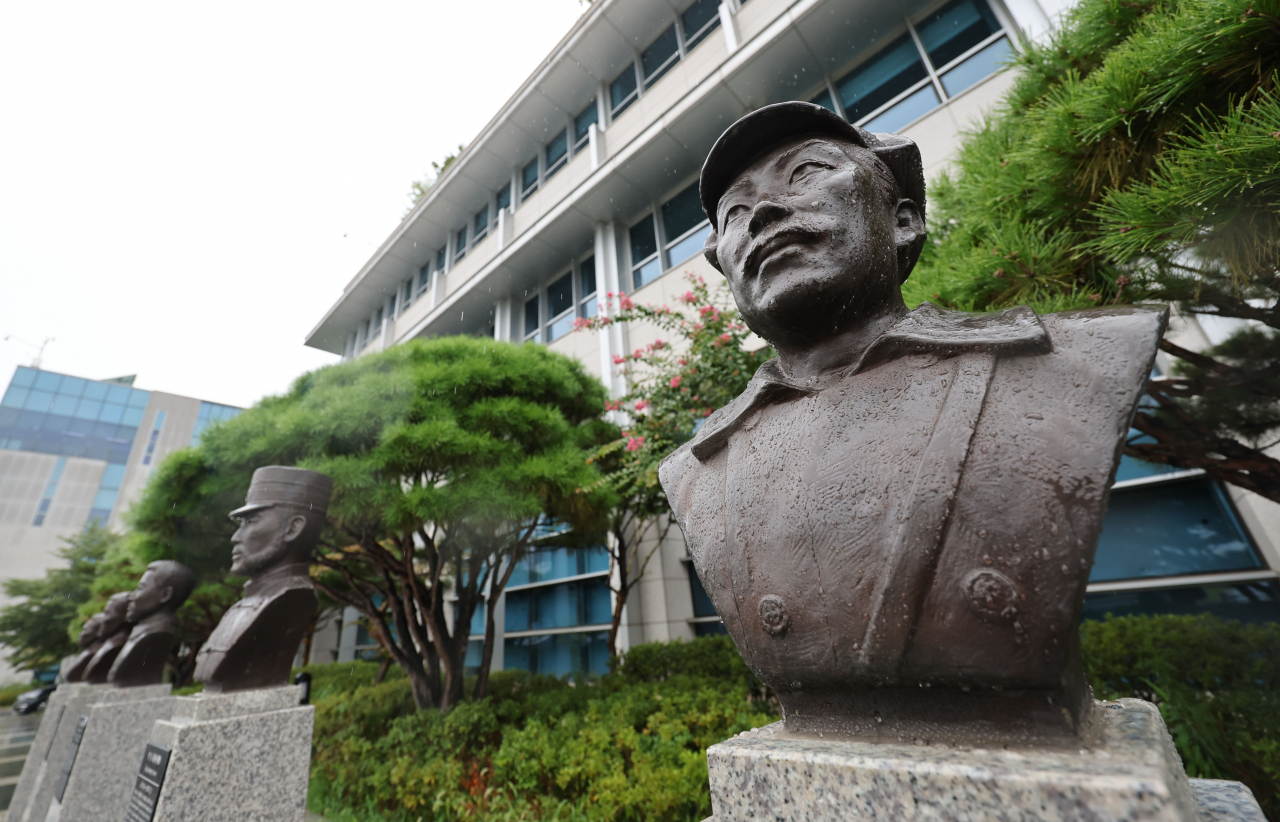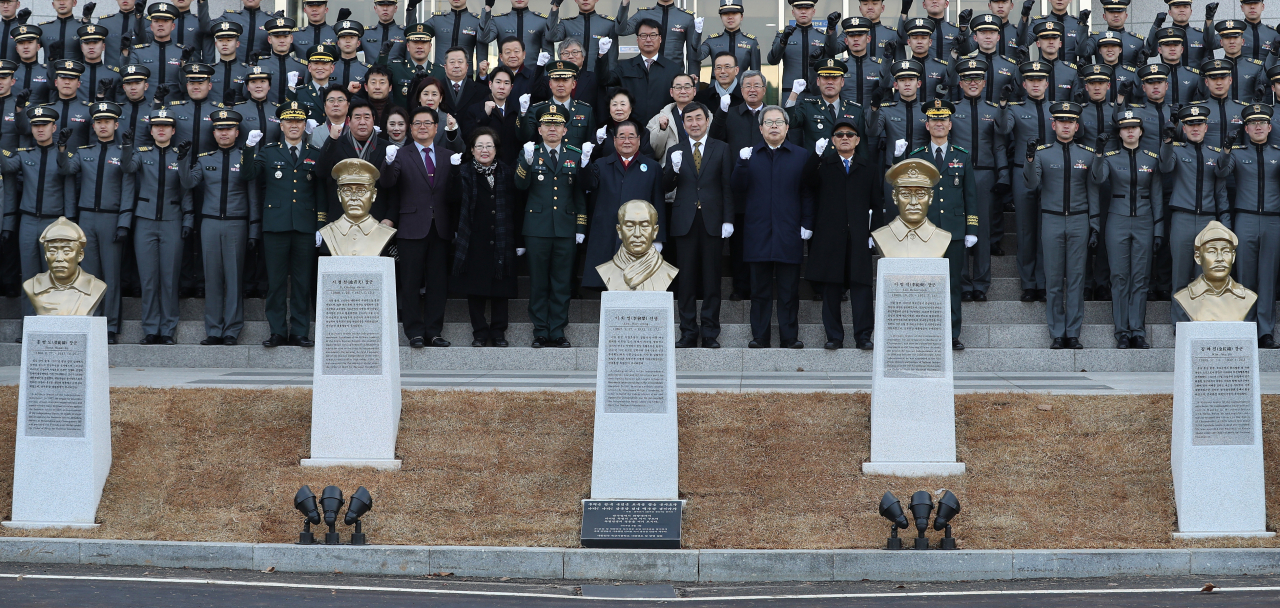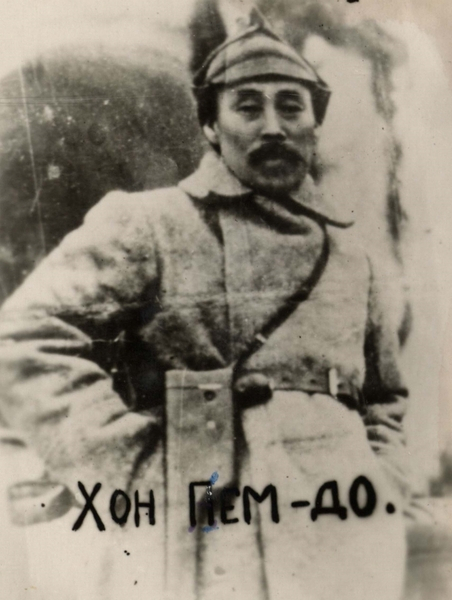 |
A bust of revered independence fighter Hong Beom-do at the headquarters of the defense ministry in Seoul on Monday. (Yonhap) |
A heated debate is unfolding over the conservative Yoon Suk Yeol administration's plan to relocate the statue of an independence activist, once again placing ideological divisions in the political spotlight.
At the center of the renewed controversy is the statue of Hong Beom-do, a prominent figure in Korean independence history, who was associated with the Soviet Communist Party during his time in the Soviet Union.
The debate was sparked when the Defense Ministry on Saturday openly acknowledged its intention to relocate the statues of five Korean independence fighters, including Hong, which are presently located at the Korea Military Academy.
The ministry went on to say Monday that Gen. Hong's historical associations with communism contradict the Military Academy's "ethos."
The ministry said it deemed it more appropriate to situate the statue of Gen. Hong within the Independence Hall of Korea in South Chungcheong Province, adding that it has initiated discussions with the Independence Memorial Hall and the Ministry of Patriots and Veterans Affairs regarding the matter.
While advocates support the move, critics blasted the Yoon administration for initiating an "anti-communist campaign," saying that it is attempting to wipe out the legacy of the preceding liberal Moon Jae-in administration.
The busts of the independence activists were brought to the Military Academy in 2018, a year after Moon became president, with the rationale that the South Korean Army's origins can be traced back to the Liberation Army and the independence fighters.
Amid intensifying debate, the presidential office stated on Tuesday that the president has not shared his thoughts on the issue. The concern is that if Yoon's stance were to be disclosed, it could potentially influence or bias ongoing discussions in a particular direction.
 |
This file photo taken in March 2018, shows the busts of five Korean independence fighters erected at the Korea Military Academy, in northern Seoul. (Yonhap) |
Hong held the position of general commander in Korea's Independence Army. He stands as a historical icon in Korea's struggle for liberation, gaining particular renown for his leadership in the Battle of Fengwudong, or Bong-o-dong in Korean. Bong-o-dong was a pivotal engagement fought against Japanese forces in northeastern China in 1920.
This victory dealt a significant blow to Japanese attempts to eradicate anti-Japanese resistance forces in Gando, highlighting the effectiveness of a unified front against the Japanese. Moreover, this triumph boosted the morale of anti-Japanese armed groups and patriotic crowds across different regions.
However, the Defense Ministry highlighted that Hong joined the Communist Party of the Soviet Union, also known as the Bolshevik Party, in 1927. After the Gando Massacre, during which Japanese military forces killed thousands of Koreans in Gando, northeastern China, Hong had to relocate to the Soviet Union -- now Russia -- to continue his independence activities.
Ban Byung-ryul, a professor emeritus at the Department of History at the Hankuk University of Foreign Studies, countered the ministry's claim that Hong's decision to join the Soviet Communist Party was primarily to secure a livelihood.
Born in 1868, Hong would have become eligible to receive a pension in 1929, two years after joining the party. Party membership was also a prerequisite for receiving land allocations and managing resources like farming plots and agricultural tools, with assistance from the Soviet government.
"He did not hold a prominent role within the Soviet Communist Party, and his membership was not driven by any specific engagement in communist activities. His decision to join was largely influenced by practical considerations that pertained to his life as an ordinary citizen," Ban told The Korea Herald.
"To categorize him solely as a communist figure, it would logically follow that he should have either joined a communist party during the 1917 Russian Revolution or participated in a communist party in Korea. However, historical records show that he did not take part in such activities during those periods," he said, adding that his contribution to the anti-Japanese armed struggle was "far more significant."
Other historians also noted that the Defense Ministry's assertion overlooks the intricacies of historical context, particularly the distinctive circumstances in which Korean independence fighters had no option but to seek assistance from communist countries to sustain their struggle against Japanese colonial rule.
In particular, Hong found himself in a situation where he was essentially left without support from the Soviet Communist Party. In line with Joseph Stalin's policy of relocating Koreans to the Far East, he moved to Kazakhstan in 1937 and passed away in 1943.
Considering the year of his death, there is no evidence to suggest that he opposed the establishment of the government of the Republic of Korea in 1948 or participated in activities that supported North Korea's ruling Workers' Party of Korea, which was officially proclaimed in 1945.
 |
This file photo shows Korean independence fighter Hong Beom-do taking part in the 1922 Congress of Peoples of the Far East in Moscow. (Photo courtesy of General Hong Beom Do Memorial) |
Conflicts within conservative camp
However, even within the conservative camp, opinions regarding Hong's statue were not unanimous.
Kim Byung-min, a member of the ruling conservative People Power Party's Supreme Council, expressed his concerns during an interview with local broadcaster SBS on Monday. He viewed the approach as "going beyond is as wrong as falling short."
Kim also clarified that Hong's accomplishments had been acknowledged by previous conservative governments. Hong was posthumously awarded the Order of Merit for National Foundation during Park Chung-hee's presidency in 1962. Additionally, during the Park Geun-hye presidency, the South Korean Navy commissioned a submarine named "ROKS Hong Beom-do" in 2016.
Kim Tae-heum, the governor of South Chungcheong Province and a member of the ruling party, also voiced his disagreement with the proposed plan.
"Before the liberation of Korea, both left-wing and right-wing factions collaborated in the pursuit of the independence movement," he said during an interview with CBS radio on Tuesday. "As a result, scrutinizing his past communist party affiliation as a significant concern is not entirely justified within this historical context."
However, the Korea Military Academy Alumni Association on Tuesday countered the opposition to the plan for relocation through a statement. The association asserted that the installation of Gen. Hong's bust lacked sufficient consensus under President Moon's administration, and has subsequently remained a contentious matter.
"The placement of sculptures for individuals with conflicting historical evaluations should be approached cautiously. In particular, figures who played a role in instigating the Korean War; engaged with North Korean, Chinese and Soviet forces; and undermined the legitimacy of the Republic of Korea should not be included," the statement read.
"It should not be allowed for cadets of the military academy to pay tribute in front of the statues of such individuals."
Shin Won-sik, a former three-star general and current lawmaker of the ruling party, also released a statement on behalf of associations of retired generals and other retired military officers. The groups asserted that the matter of installing statues of independence activists is fundamentally within the purview of the military academy itself, urging the removal of the busts.
But Seo Kyoung-duk, a professor of general education at Sungshin Women's University, highlighted the peril posed by the political exegesis in the struggle for independence — an "essential historical thread woven into the fabric of the Republic of Korea."
"I hold a conviction that approaching these aspects exclusively from a political or ideological standpoint poses significant risks," Seo told The Korea Herald. "If we continue down this path, it could potentially exacerbate deep divisions among our citizens."
Cha Du-hyeogn, a principal fellow at the Asan Institute for Policy Studies, emphasized that the fundamental question revolves around whether figures like Hong and other independence fighters pose a genuine threat or harm to South Korea, irrespective of the ideologies they adhered to.
In South Korea's history up to the present day, there have been countless sacrifices, tears, and tireless efforts by trailblazers that have persisted up, Cha said. Throughout the journey, those who exhibited unwavering commitment in the midst of formidable challenges were genuinely exceptional, he added.
"The stance of a diverse South Korea should entail commemorating and honoring all, except those who were evidently engaged in hostile actions against Korea or unambiguously endorsed Japanese imperial rule," Cha emphasized. "Why strive to construct a history of omissions, and whose benefit does it exactly serve?"







![[Today’s K-pop] Blackpink’s Jennie, Lisa invited to Coachella as solo acts](http://res.heraldm.com/phpwas/restmb_idxmake.php?idx=644&simg=/content/image/2024/11/21/20241121050099_0.jpg)